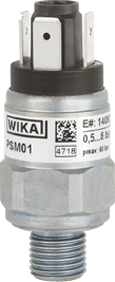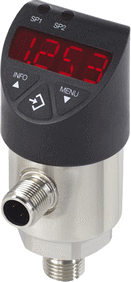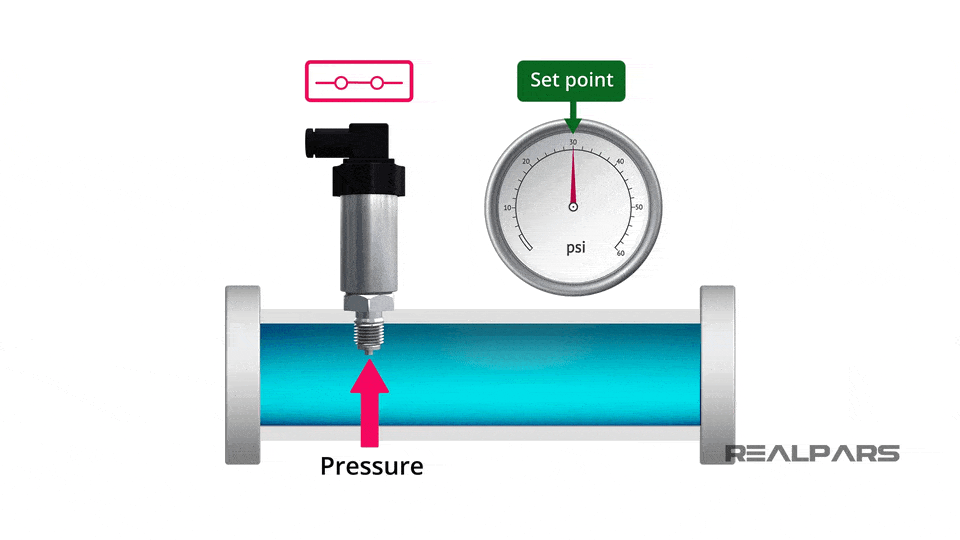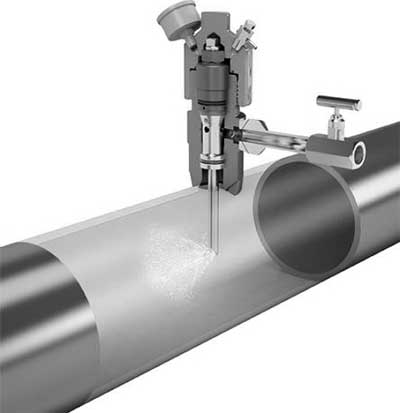What is a Pressure Switch?
A pressure switch is a mechanical or electronic device that is activated when the pressure of the process fluid reaches a certain threshold or set point.
The pressure switch can vary according to whether it consists of a bourdon tube, piston, diaphragm or diaphragm that moves or deforms depending on the pressure applied by the system.
For example, an air pressure switch is used to maintain a constant pressure and can shut off the compressor once the tank reaches the required air pressure level. If the air pressure drops and more is needed, the switch can also turn on the compressor.
Pressure switches should not be confused with pressure transducers. The latter convert pressure into an electrical output signal.
A pressure switch consists of the following major components..
- Diaphragm - A diaphragm is used to detect pressure. The material is usually pliable and sensitive to pressure
- Spring - Used for setting set points or trip points
- Lever - Used to activate or deactivate the switch
- Electrical contacts - Let power through from an external power Reference(s)
- Terminals - To connect the external power source to the contacts
Types of pressure switches
There are two main types of pressure switches.. mechanical pressure switches and electronic pressure switches.
Mechanical pressure switch
These simple and robust switches are usually used for less complex tasks. Mechanical pressure switches
are activated using a spring and a piston to control the pressure at which they are activated.
The spring is the force that counteracts the inlet pressure, and its tension is set via a set screw
or knob. In turn, the spring preload is directly related to the pressure at which an electrical
contact occurs. When pressure drops, the switch returns to its original state. The mechanical pressure
switch is better suited to handle high voltages and currents than an electronic pressure switch.
You can use them to increase or decrease pressure by contact change.

Mechanical
Pressure Switch

Electronic
Pressure Switch
Images.. blog.wika.com
Electronic pressure switch
Electronic pressure switches contain a pressure transducer, usually a strain gauge, and additional
electronics that convert the signals into a readable output. An electronic pressure switch offers
many advantages over a mechanical pressure switch. Some advantages include greater accuracy, less
contact wear, excellent long-term stability, easy operation and the ability to perform thousands
of switching cycles.
General applications
A pressure switch can be used in a wide range of domestic and commercial applications, as listed below..
To monitor and control system air pressure, HVAC, gas cylinders, air pumps, etc. use air compressor pressure switches. When the engine oil pressure drops below the preset level, oil pressure switches are used to determine when the oil pressure has dropped. Both industrial and domestic furnace pressure switches serve as safety devices. In the event of low air pressure during furnace startup, they shut down the furnace.
A well pump pressure switch is used in both residential and commercial buildings to draw water from the well and ensure that there is enough water pressure in the system to deliver water without overpressurizing.
Residential, commercial and agricultural water pumps use pressure switches to automatically control the flow rate.
A vacuum pressure switch measures the vacuum in the system or negative pressure. These components are found in boilers, electric heaters, air compressors and transmission systems.
Selection criteria for pressure switches
There are several selection criteria to consider when selecting pressure switches. Some of the important criteria are listed below..
Operating temperature: The operating temperature affects the material used. Certain materials degrade at high temperatures.
Process fluid: The chemical properties of the process fluid determine the type of material needed for the wetted parts. The wetted parts are the ports, seals and the pressure side of the pressure-sensitive component. These parts must withstand any chemical or physical attack from the process fluid. Degradation of parts can occur through corrosion, oxidation or erosion.
Type of pressure: Pressure switches are often used in systems with positive pressure. They can also be used in vacuum applications. Negative pressure systems require pressure switches specified for vacuum and compound pressure. Membranes are ideal for vacuum and low-pressure applications. Pistons are ideal for high-pressure applications.
Pressure range: Pressure switches have a range that defines their on and off pressure; this is often referred to as the operating range. As a precaution, it is recommended that the set point be 40 to 60% of the pressure range.
Operating temperature: The operating temperature also affects the material used. Certain materials degrade at high temperatures.

Related Post(s)

Access fittings provide access to systems under full operating pressure up to 500bar...